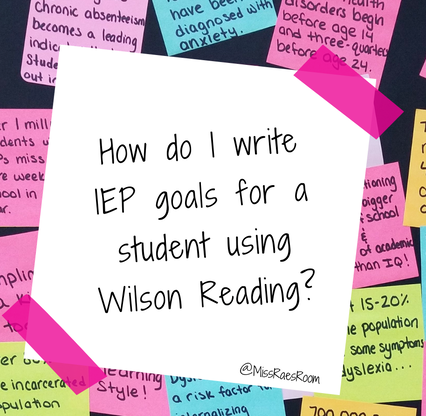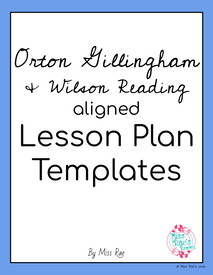

Help! How do I write IEP goals for a student using Wilson Reading?
I see students in a one-to-one and small group setting for reading. I use the Wilson Reading System with all of my students, but I struggle to write IEP goals because I ONLY use this program with them. How do I write IEP goals for a student using Wilson Reading?
Sincerely,
Goal-Less Wilson Reading Teacher
Students with specific learning disabilities in reading need specialized reading instruction.
Wilson Reading, Spire, and Project Read are examples of specialized curriculums that are based on Orton-Gillingham methodologies. Such programs work for students with learning disabilities in reading because they provide direct and explicit structured, sequential multisensory teaching of the basic elements of language for improved decoding and encoding!
All levels of language, including sounds (phonemes), symbols (graphemes), meaningful word parts (morphemes), word and phrase meanings (semantics), sentences (syntax), longer passages (discourse), and the social uses of language (pragmatics) are taught in conjunction with each other. This can make it difficult to write a targeted IEP goal.
So let me help you out! Here are some IEP goals and objectives to choose from, aligned to the Wilson Reading System!

SAMPLE GOALS:
Given specialized instruction using a multisensory systematic phonics-based program, XXX will increase his/her reading levels for comprehension, decoding, and fluency to an end of first grade reading level by the end of the IEP period as measured by XXX (i.e. NWEA MAP).
Given a multisensory language based explicit instruction in developmental skills which lead to decoding and word recognition, XXX will increase his/her reading skills for comprehension, decoding, encoding, phonics, word recognition and vocabulary development, to at least one grade level above his/her current instructional text level (XXX) with at least 97% accuracy by the end of the IEP period as measured by XXX (i.e. NWEA MAP).
When given a list of 20 nonsense words XXX will be able to accurately decode multisyllabic words that contain closed, open, vowel teams and vowel-consonant-e (beside, statement, remain) syllable types with 90% accuracy as measured by XXX (i.e. Wilson charting records).
Given direct instruction using a systematic and scientifically based reading instruction program, XXX will demonstrate accurate knowledge of reading skills showing one year's growth as measured by XXX (i.e. NWEA MAP) with 95% accuracy.
Given direct instruction using a systematic and scientifically based reading instruction program, XXX will increase his/her reading levels for comprehension, decoding, encoding, and fluency from his/her current level of being able to use 1 syllable type (closed) to being able to use all 6 syllable types as measured by the end of the IEP period as measured by XXX (i.e. Wilson charting records).
SAMPLE OBJECTIVES:
Decoding: Given 15 words in isolation at his/her instructional level, XXX will correctly and independently decode 80 percent of the words accurately.
Decoding: Given 15 non-contextualized CVC, CCVC, CVCC, and/or CVCe words at XXX's instructional level, XXX will correctly decode 80 percent based on teacher notes and charting.
Decoding: Given 15 words in isolation at his/her instructional level including words containing all 6 syllable types and learned prefixes and suffixes, XXX will independently and accurately decode 85 percent of the words.
Fluency: Given text and passages using controlled text at his/her independent reading level, XXX will be able to read 3-4 words together at a rate of 90 wpm based on charts, DIBELS and teacher notes.
Fluency: When given text or reading passage at his/her independent reading level, XXX will use knowledge of decoding skills and word recognition to increase his/her fluency reading orally with appropriate rate, and expression at 90 words per minute with 90% accuracy.
Encoding (Spelling): Given dictation for spelling and grammar, XXX will correctly spell 75 percent of the words at his/her current instructional level based on student samples and teacher record.
Comprehension: Given sentences, paragraphs and reading passages at his/her instructional reading level (controlled-text), XXX will be able to independently use visualization and retell the facts/events with 90 percent accuracy based on teacher notes and benchmark assessments.
Comprehension: XXX will use learned reading strategies of summarizing, questioning, inferencing, making connections and predicting to answer right there and higher order thinking questions from text at his/her instructional level in 4 out of 5 opportunities with up to 2 cues.
Vocabulary: XXX will utilize decoding and context clue strategies to understand unfamiliar words when reading (orally and/or silently) content area texts with decreasing adult assistance in 4 out of 5 observations with 80 percent accuracy.
Happy & Healthy Teaching!
Miss Rae